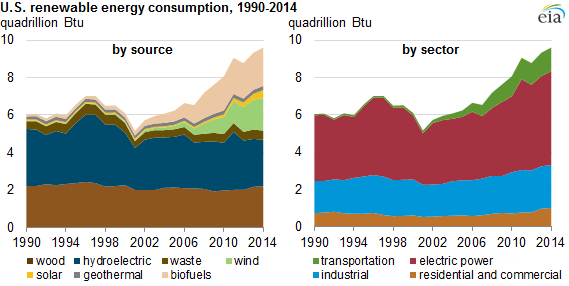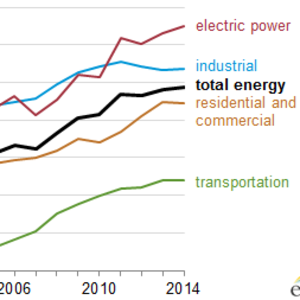Renewable share of US energy consumption highest since 1930s



Source: EIA
May 28, 2015
BY The U.S. Energy Information Administration
Renewable energy accounted for 9.8 percent of total domestic energy consumption in 2014. This marks the highest renewable energy share since the 1930s, when wood was a much larger contributor to domestic energy supply.
Renewable energy use grew an average of 5 percent per year over 2001-‘14 from its most recent low in 2001. The increase over the past 14 years was in part because of growing use of wind, solar, and biofuels. Wind energy grew from 70 trillion Btu in 2001 to more than 1,700 trillion Btu in 2014. During the same period, solar energy (solar thermal and photovoltaic) grew from 64 trillion Btu to 427 trillion Btu, and the use of biomass for the production of biofuels grew from 253 trillion Btu to 2,068 trillion Btu. Hydroelectricity was the largest source of renewable energy in 2014, but hydro consumption has decreased from higher levels in the mid-to-late 1990s. Wood remained the second-largest renewable energy source, with recent growth driven in part by demand for wood pellets.
In 2014, slightly more than half of all renewable energy was used to generate electricity. Within the electric power sector, renewable energy accounted for 13 percent of energy consumed, higher than its consumption share in any other sector.
The industrial sector used 24 percent of the nation's renewable energy in 2014. Nearly all of that renewable energy was biomass, which included wood, waste, and biofuels used in manufacturing processes as well as in the production of heat and power. The production of biofuels results in energy losses and coproducts, which are also included in industrial consumption of renewables.
Advertisement
Advertisement
About 13 percent of the renewable energy used in the U.S. is now consumed in the transportation sector, which experienced the largest percentage growth in renewable consumption from 2001 to 2014. The growing demand for liquid biofuels, including both ethanol and biodiesel, pushed renewables to nearly 5 percent of the sector's energy consumption in 2014.
A greater use of wood for home heating and steadily growing installation of solar systems are the main contributors to increasing renewable energy consumption in residential buildings and, to a lesser extent, in commercial buildings.
Advertisement
Advertisement
Related Stories
Global digital shipbuilder Incat Crowther announced on June 11 the company has been commissioned by Los Angeles operator Catalina Express to design a new low-emission, renewable diesel-powered passenger ferry.
ATR and French SAF aggregator ATOBA Energy on June 19 signed a memorandum of understanding (MOU) to explore ways to facilitate and accelerate sustainable aviation fuel (SAF) adoption for ATR operators.
Argent Fuels, a leading provider of carbon-saving fuels in the UK, is accelerating its efforts to support a greener future. The expansion of its High Blend Biodiesel will supply to bus, coach, HGV fleets and rail in the south of the UK.
Sprague Operating Resources LLC on June 24 announced it has been selected by the New York City Department of Citywide Administrative Services to supply renewable diesel for its marine fleet, including the iconic Staten Island Ferry.
On June 17, the NYC Department of Citywide Administrative Services and the Department of Transportation announced the start of the Staten Island Ferry’s transition to renewable diesel, marked by the delivery of the first barge of fuel.
Upcoming Events










